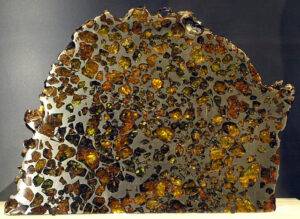
What’s Inside Meteorites? Exploring the Cosmic Composition
Meteorites are cosmic messengers, carrying clues about the formation of the solar system, planetary processes, and even the origins of life. These extraterrestrial fragments, which survive their fiery journey through Earth’s atmosphere, are scientifically invaluable due to their pristine preservation of ancient material. This article delves into the fascinating world of meteorites, revealing their compositions, structures, and the insights they provide into the cosmos.
Introduction to Meteorites
Meteorites are pieces of debris from celestial bodies like asteroids, comets, or planets that survive the descent through Earth’s atmosphere and land on its surface. They are classified into three primary categories based on their composition:
- Stony Meteorites (Chondrites and Achondrites): These are the most common, making up about 94% of all known meteorites.
- Iron Meteorites: Composed predominantly of iron and nickel alloys, they originate from the cores of differentiated planetary bodies.
- Stony-Iron Meteorites: A rare blend of metal and silicate minerals, these meteorites offer a glimpse into the interface between core and mantle regions of planetesimals.
How Are Meteorites Formed?
Meteorites are fragments of larger celestial bodies ejected by high-energy collisions in space. These collisions may involve asteroids, comets, or proto-planetary bodies. Over millions of years, these fragments travel through space until gravitational interactions or orbital alignments direct them toward Earth.
Connection with Asteroids and Comets:
- Asteroids: Many meteorites originate from asteroid belt objects, offering insights into primordial materials.
- Comets: Cometary meteorites are rarer but provide information about volatile-rich regions of the solar system.
Types of Meteorites and Their Composition
Meteorites vary significantly in their composition and origin:
- Chondrites:
These stony meteorites contain small, spherical particles known as chondrules, formed from molten droplets in the early solar nebula. They also include calcium-aluminum-rich inclusions (CAIs), which are among the oldest materials in the solar system. - Achondrites:
Unlike chondrites, these meteorites lack chondrules. They originate from differentiated parent bodies where melting and crystallization occurred. - Iron Meteorites:
Composed mainly of iron and nickel, they often display a unique Widmanstätten pattern, a crystalline structure visible upon etching. - Stony-Iron Meteorites:
These rare meteorites are a mix of metallic iron-nickel and silicate minerals, representing core-mantle boundaries of disrupted planetesimals.
Elemental and Mineralogical Composition
Meteorites contain a wide range of elements, including common terrestrial ones like silicon, oxygen, and iron, as well as rarer elements such as iridium, which is linked to the extinction event that ended the Cretaceous period.
Key Elements:
- Iron and Nickel: Dominant in iron meteorites.
- Magnesium and Silicon: Abundant in stony meteorites.
- Iridium and Platinum: Found in trace amounts, these are significant in studying asteroid impacts.
Organic Compounds in Meteorites
Meteorites often harbor organic compounds, making them crucial for astrobiology. For instance, the Murchison meteorite contains amino acids, the building blocks of life. Complex molecules like PAHs (Polycyclic Aromatic Hydrocarbons) suggest that prebiotic chemistry might be widespread in the cosmos.
Isotopic Signatures and What They Reveal
Meteorites contain isotopic signatures that provide a timeline for the solar system. Radiometric dating techniques, such as uranium-lead or argon-argon dating, help determine the age of these space rocks, often placing them at over 4.5 billion years old.
Microscopic Structures in Meteorites
Advanced imaging techniques have uncovered intricate microscopic structures in meteorites:
- Chondrules: Glassy spheres within chondrites.
- CAIs: High-temperature inclusions.
- Nanodiamonds: Microscopic diamonds formed under intense pressure.
FAQs
- What is the most common type of meteorite?
Chondrites are the most common type, accounting for 85–90% of meteorite finds. - What elements are unique to meteorites?
Rare elements like iridium and platinum are often found in meteorites and are less common on Earth. - Can meteorites contain water?
Yes, some meteorites, particularly carbonaceous chondrites, contain hydrated minerals. - How are meteorites analyzed?
Techniques include spectroscopy, electron microscopy, and isotope ratio mass spectrometry. - What can meteorites tell us about asteroids?
Meteorites provide direct samples from asteroids, revealing their composition and history. - Are meteorites linked to the origins of life?
Yes, they contain organic molecules like amino acids, which are essential for life.










